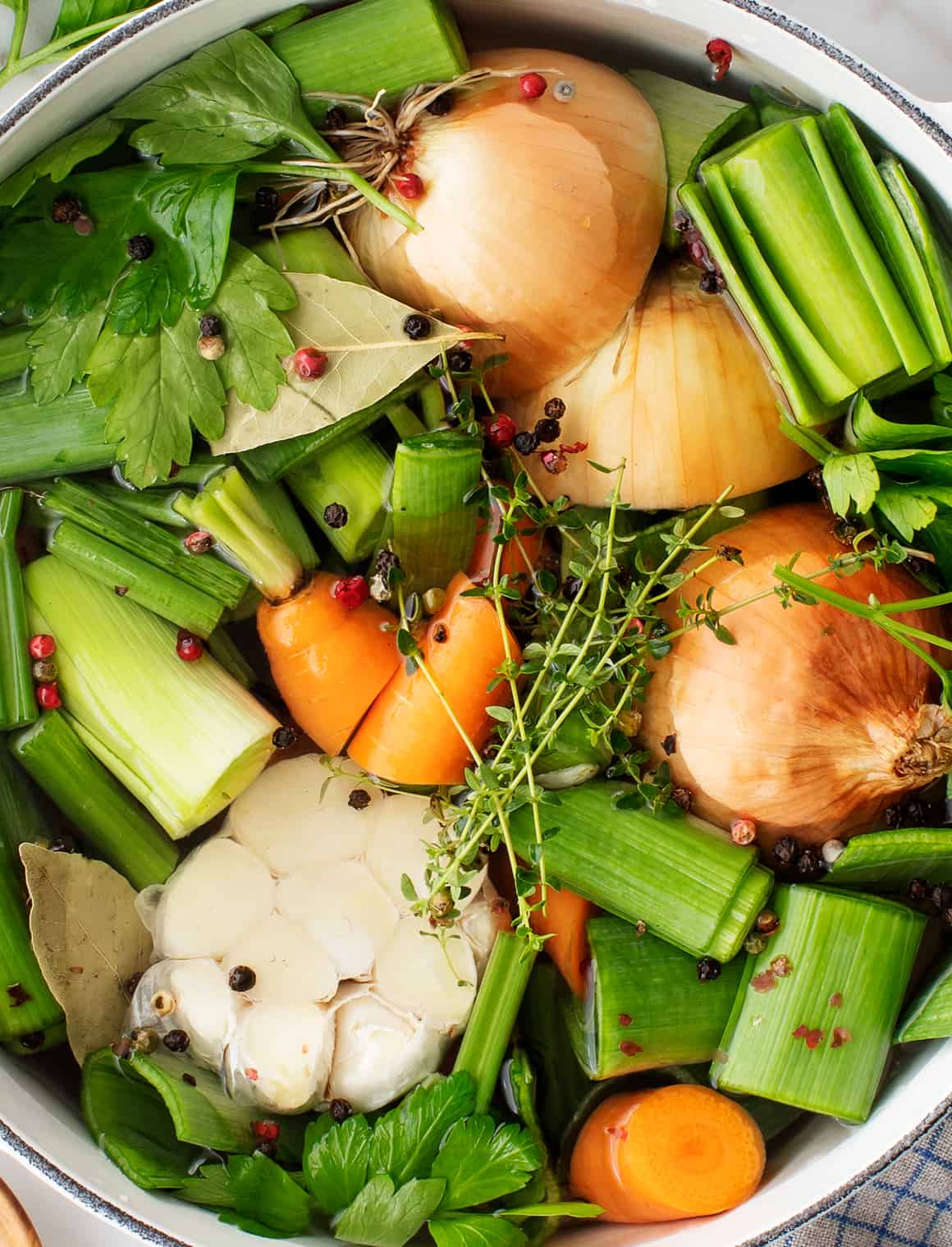Learn how to make vegetable stock! Perfect for using in soups, sauces, risottos, and more, this homemade broth is super flavorful and easy to make.

The other day, I was making vegetable stock with veggie odds and ends I’d accumulated throughout the week. As I stood in the kitchen, savoring the delicious aroma wafting from my stock pot, I realized that I had yet to share my method for how to make vegetable broth on the blog. I have over 80(!!) soup recipes on here, and another soup season is right around the corner. Suffice it to say, this vegetable stock recipe is long overdue.
I’m so excited to share it today because I believe that vegetable stock is something that everyone can and should make at home. It’s unbelievably easy and cheap, and it tastes SO much better than any broth you’d find at the store. Don’t worry – I’ll never blame you for reaching for store bought broth when that’s the most convenient option (I still use it sometimes too!). But whenever you do make your own, the extra time and effort will always be worth it.

Vegetable Stock Recipe Ingredients
I have two methods for how to make vegetable broth. The first starts with fresh, aromatic veggies. I use
- onions,
- garlic,
- carrots,
- celery,
- and herbs like thyme and parsley.
Then, to give the broth even more depth of flavor, I add salt, whole peppercorns, leek tops, and bay leaves.

In the second method, I use vegetable scraps instead of the vegetables themselves. This method keeps these veggie odds and ends from going to waste, and it yields a super tasty broth. As it turns out, the parts of vegetables that we normally toss are actually packed with flavor.
All sorts of scraps can contribute to a flavorful stock. Here are a few that work especially well:
- leek tops,
- fennel fronds,
- carrot tops,
- herb stems,
- corn cobs,
- mushroom stems,
- scallion roots or tops,
- onion skins and ends,
- and garlic skins and ends.
Steer clear of veggie scraps from cruciferous vegetables like broccoli, cabbage, or cauliflower, as they can make your stock bitter.
Tip: Keep a freezer bag or container of veggie scraps in your freezer and add to it whenever you cook. When you have about 6 cups of frozen scraps, it’s time to make veggie stock!

How to Make Vegetable Broth
Whether you’re using whole vegetables or vegetable scraps, making homemade vegetable broth is incredibly easy.
- First, wash the vegetables well. You don’t want to simmer any dirt or sand in your stock!
- Next, chop them. The shape isn’t important – you just need to break them down enough so that they fit neatly in your pot.
- Then, simmer. Add the vegetables to a large pot with the salt, bay leaves, and peppercorns. Add 10-12 cups of water and simmer, covered, for 1 hour.
- Finally, strain the stock through a fine mesh strainer to remove the vegetables and peppercorns.
That’s it!
Find the complete recipe with measurements below.

Storing and Using Homemade Vegetable Stock
Allow the stock to cool to room temperature. Then, store it in an airtight container in the fridge for up to 5 days, or freeze it for several months. (Psst! When you have a stash of homemade vegetable stock in your freezer, it’s just as convenient as the store bought kind!)
Use the homemade stock as you would any veggie broth – in recipes for stuffing, gravy, pasta sauce, and risotto, and, of course, soup. Find my favorite soup recipes below.

Favorite Soup Recipes
Once you make this vegetable broth recipe, try using it in one of these soups:
- Butternut Squash Soup
- Cabbage Soup
- Many-Veggie Vegetable Soup
- Tortellini Soup
- Tomato Basil Soup
- Potato Leek Soup
- Easy Vegetarian Chili
- Or any of these 30 Best Soup Recipes!

Vegetable Stock
Ingredients
- 2 medium onions, halved
- 4 medium carrots, chopped
- 1 to 2 medium celery stalks, chopped
- Leek or fennel tops, chopped
- 1 garlic bulb, halved
- Handful fresh parsley
- 1 small bunch fresh thyme
- 3 bay leaves
- 2 teaspoons sea salt
- 1 teaspoon black peppercorns
- 10 to 12 cups filtered water
Instructions
- Place the onions, carrots, celery, leek tops, garlic, parsley, thyme, bay leaves, salt, pepper, and water in a large pot and bring to a boil over high heat (If 12 cups of water won’t fit in your pot, you can use 10). Reduce the heat and simmer gently, covered, for 1 hour.
- Strain and discard the vegetables. Season to taste and use in your favorite soup recipes.














Fabulous! I love your recipes thankyou! X
So glad you love the recipes, Julie!
This approach really does yield a very flavorful vegetable broth. I froze clean chopped vegetable trimmings in a gallon zipper bag, adding to it over time. I put in just about everything but cruciferous (thx for that tip!), even wilted salad greens and a few potato peelings. When the bag was full it was time to make broth using your recipe. I froze the broth in quart portions, these thaw quickly and go in any number of recipes. I feel like I am making good use of every bit of food possible, which is good stewardship of resources and an ethical behavior. Thank you for posting this recipe. It is superior to ones I’ve tried previously.
Good recipe